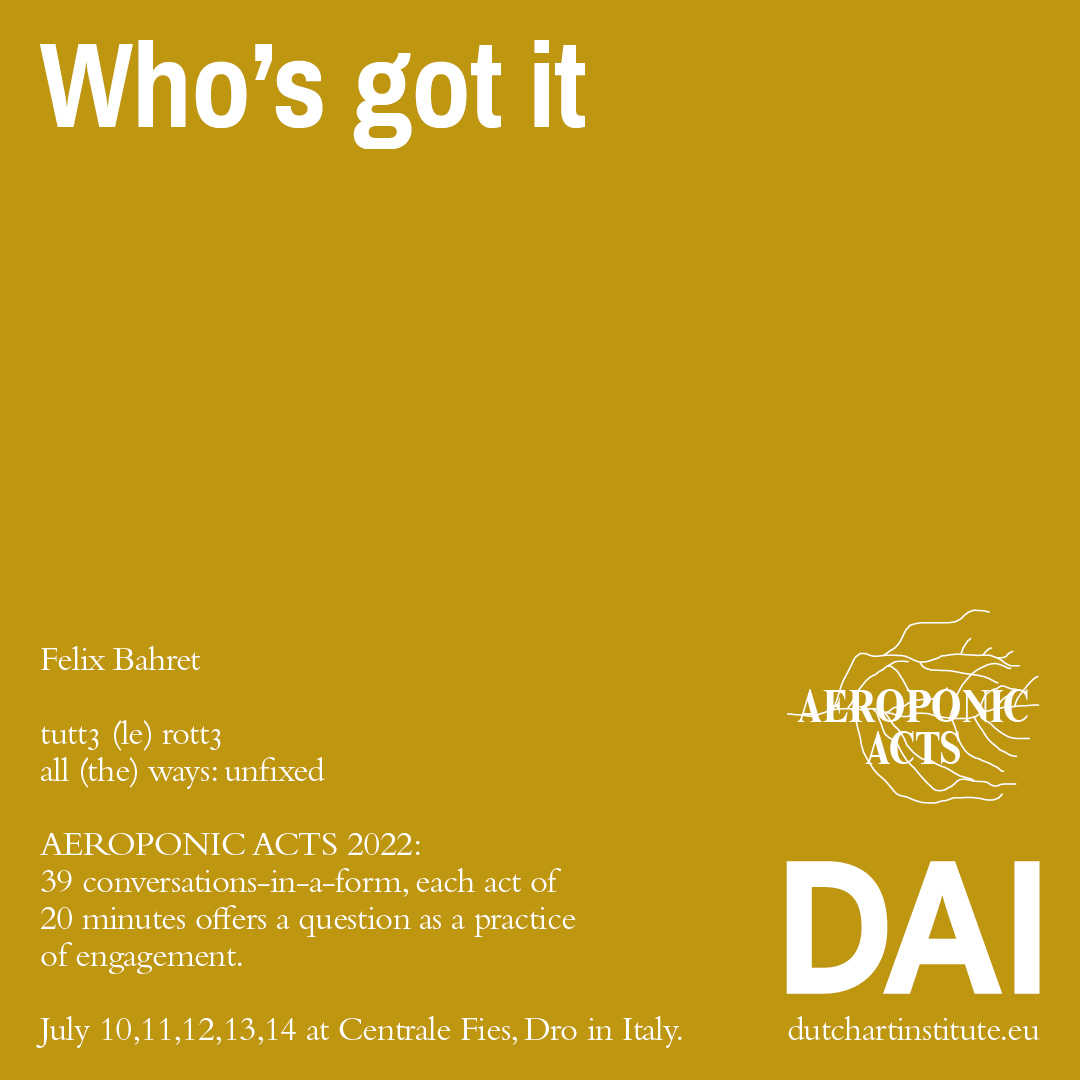Felix Bahret: Amnesia Haze
’Aeroponic’ – root systems nourished by air – Acts is the name given to the nomadic Dutch Art Institute’s final Kitchen presentations. Each participant addresses one question, as a practice of engagement.
Here you will find the documentation of Felix Bahret's presentation as filmed by Baha Görkem Yalım. The written report is by Hubert Gromny and it includes a summary of the comments by esteemed guest respondents.
Amnesia Haze
Felix's question: Who’s got it
Felix's introduction: Such was the startling of affairs their confusion over what was theirs and what wasn't that others when talking about their mothers induced in them a sense of quilt which was neither knit nor guild
less a fear of abandon but more like a bite in their missing sculpture say what you will about
transitionary objects I shout rabbit eye I hear these stories from a land before our time and first hand
where one goes to undo the payment plan due in the next 48 hours I sing losses over gains
Hubert's report: Audience enters the dark space with the stage illuminated by the strong white light. Felix is sitting on the stage. In front of him a microphone is lying on the floor. Voice from the speakers announces the title of the piece: “Amnesia Haze”. After giving some time for the audience to settle in Felix takes the microphone and starts telling a rhymed story. “Such was the startling of affairs | their confusion over what was theirs | and what wasn't | that others when talking about their mothers | induced in them a sense of quilt which was neither knit nor guilt”. The way the poem is recited and performed give an impression that recalling the lines is an effort and an extensive use of end rhymes present itself as a mnemotechnic. At moments other voices join from the speakers and are usually correcting Felix’s recitation or helping him to find a word missing. The dynamics of the performance is built on the tensions between the lack of memory and fragmented narratives, interweaving humorous anecdotes with personal, almost psychoanalytic, moments of introspection. A recurring theme within the performance is recollecting the lyrics of the song “Come Along” by Titiyo. The performance ends with Felix singing lines: “Come along now | Come along with me | Come along now | Come along and you´ll see | What it's like to be free”
Momtaza Mehri observed the associative nature of the work and pointed out to the voices calling ‘from above’ as providing commentary from the position of an authority—a teacher or a mother. The associative nature of the work evoked mother-child connection in a poetic way. Momtaza noted that the poetic method of the presentation was engaging the audience and in this aspect reminded her of British ranting poetry (John Cooper Cloke, Attila The Stockbroker). Listing banalities, the playful mocking nature of intimate relationships mentioned in the piece tap into other poetic traditions. From another angle Momtaza commented on the improvisational aspect of the work. Various repetitions and pronunciations within the monologue brought themes of childhood innocence, introductions to feelings of abandonment and one's fears of that feeling. Moments when Felix was laughing on his own words were moments of reckoning with something serious and trying to maintain the balance and productive space between poetic rigor and improvisation.
Chiara Figone emphasized the belonging of the piece to the genre of comedy and complemented its simplicity. Chiaara appreciated the straightforward embodied presence of the performing body on the stage, which managed to navigate away from the usual formulation of white masculinity and its models of reckoning with childhood. The presentation gave access to this experience from a different point. The simplicity of the form allowed it to reflect on the thematic topic of the piece of an amnesia and erasure.
Phanuel Antwi described the presentation as a mobilization of therapeutic modalities such as psychodynamic or psychodrama session in a form of comedy. One of such therapeutic techniques is also free association in which both the therapist and patient say whatever comes to their minds at the moment. Free association is a way to let the subject not cling to the guilt about what is brought into the place during the session. It was interesting to see how associative technique was used as a container for an artistic approach proposing a practice which does not require editing. This non-editing practice however has a circular quality as it eventually leads to a certain mode of editing, nevertheless the translation of certain therapeutic methods into aesthetic forms was an interesting contribution of the piece.
About: Felix Bahret
Felix Bahret's "Amnesia Haze" was presented before live audience at the Centrale Fies, Dro, Italy on July 13th.
Find the overview of all 24 AEROPONIC ACTS 2022 here: tuttə (le) rottə - all (the) ways: unfixed


